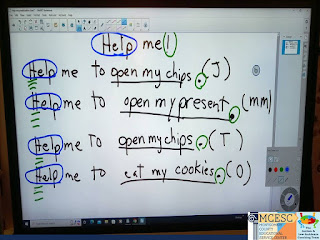Comprehensive Literacy Instruction is essential in today's classrooms, including self-contained classrooms and cross-categorical resource rooms. In many cases, reading and writing instruction has fallen by the wayside for our most complex learners however the push toward implementing the Science of Reading in all classrooms emphasizes the need for a shift.
Shared Writing is one component of Comprehensive Literacy Instruction and a highly effective strategy for engaging students with complex needs in shared writing instruction is Predictable Chart Writing (PCW). PCW provides predictability, offers seamless integration of communication, and can be utilized as an activity for the entire classroom, small groups, or even individual sessions. Today's Academic Area post will break down the 5 steps to the Predictable Chart Writing routine. We want to extend a special thank you to Cynthia Resch at MCESC Learning Center-West for welcoming us into her classroom to model each step of the PCW routine for us to share!
Each step in the Predictable Chart Writing Routine takes place during a new session. Typically, this is done during daily writing instruction over the course of a school week.
Step 1: Write the Chart (Monday)
- Choose a sentence stem. Possible topics could include the current classroom theme, responding to a recent reading passage, or incorporating the use of core words.
- The students provide a personalized response to the sentence stem.
- Then, the teacher scribes the response on the chart while saying each part aloud.
- Finally, the group will choral read each sentence when done.
- For non-speaking students, utilize AAC such as a big mack switch, communication board, or communication device to facilitate participation. See the example video below:
Step 2: Reread the Chart (Tuesday)
- First, the group will reread the entire chart chorally as the teacher points to each word.
- Then, provide opportunities for individual students to find words such as a targeted core word or content vocabulary.
- Next, focus on a specific element (letter, word, convention) when done.
- Finally, reread a final time.
Step 3: Work with Sentence Strips (Wednesday)
- First, the group will reread the entire chart chorally as the teacher points to each word.
- Next, pass out each student’s contribution to them on sentence strips.
- You can either prepare these sentence strips ahead of time or use this activity as an opportunity to model.
- Then, demonstrate how to cut the sentence apart into words (after each cut, reread) and reorder.
- Eventually, start reordering incorrectly to help students see if the sentence makes sense.
- Allow students to make mistakes! These are opportunities to recheck work/check for what makes sense
- After developing an understanding, students will cut apart their own sentences.
Step 4: Be the Sentence (Thursday)
- First, the group will reread the entire chart chorally as the teacher points to each word.
- Then, choose a sentence.
- Next, write on a sentence strip, and then cut it apart.
- You can either prepare these sentence strips ahead of time or use this activity as an opportunity to model.
- Then, give each student a word from the sentence and have them physically arrange themselves to reorder the sentence
- Repeat for 3-4 sentences.
- Finally, end with a final choral reading of sentences.
Step 5: Make and Publish the Book (Friday)
- First, the group will reread the entire chart chorally as the teacher points to each word.
- Then, pass out individual sentences typed/written for book.
- You can either prepare these sentence strips ahead of time or use this activity as an opportunity to model.
- Next, students cut apart their sentences and reorder.
- Staff will guide students to self-edit by referring to the chart.
- Then, they will glue their ordered sentence onto their paper.
- Next, students will add illustrations
- They can use their own drawings or find pictures on Google images.
- Finally, add the finished class book to classroom library.
- You can also publish the class book to Tarheel Reader or Bookcreator.com for independent reading with technology or at home.
To see Predictable Chart Writing in action with a group of learners at a variety of instructional levels, check out this video:
For additional information on implementing Predictable Chart Writing in your classroom, we encourage you to check out these wonderful resources:
Online Modules
Books
Websites















No comments:
Post a Comment